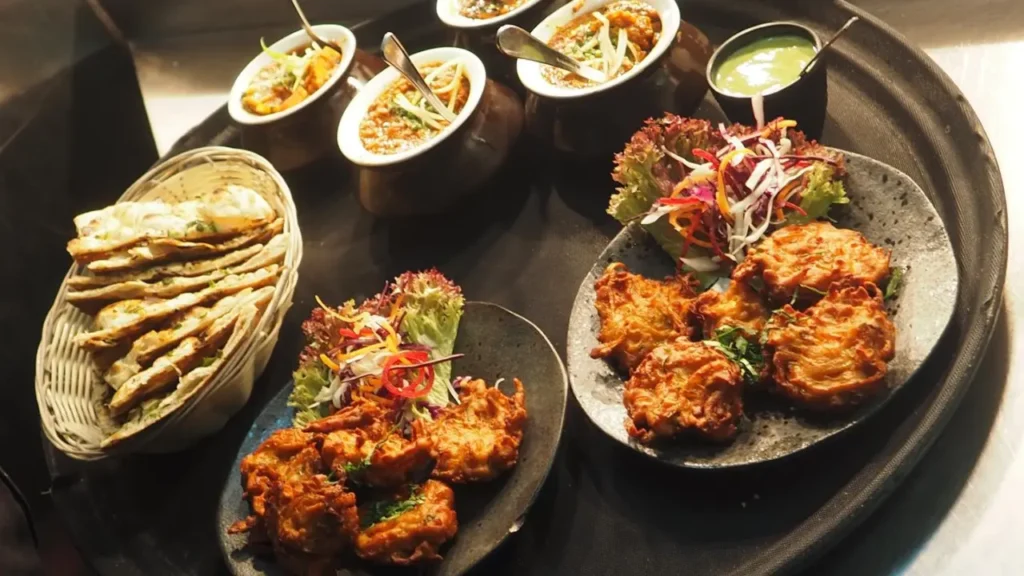Tourists often worry about Dubai food prices before they land in this sparkling desert city. Costs can swing widely, yet clear trends help travelers and residents plan meals with confidence. By knowing averages, visitors avoid shocks and locals manage monthly budgets without stress.
Prices rise with location, cuisine style, and choice between cooking at home or dining out. Downtown hotspots cost more than suburban cafeterias, yet deals exist everywhere if you look. This guide breaks down typical numbers, adding context and smart tips for every appetite.

Street Food
Street stalls in Deira or Satwa serve shawarma, falafel, or biryani for AED 10–30, an easy bargain. You stand at the counter, pay a small price, and eat fresh food that locals enjoy daily. Besides saving money, you taste authentic spices and chat with friendly vendors.
Even with recent inflation, these carts remain stable because rent and staff costs stay low. Order water or karak chai for AED 1–2, and your whole meal still sits under USD 3. Such value explains why busy workers and students rely on street fare between long shifts.
Fast Food Chains

International fast food chains reflect dubai food prices that balance global consistency with local demand. Expect a combo meal at McDonald’s, KFC, or Burger King to cost AED 35–60, fries included. Prices rise slightly at malls near tourist attractions, yet coupons cut costs sharply.
Weekday lunch deals often bundle burgers and drinks for under AED 40, pulling crowds. Drive-through lines move quickly, so commuters grab meals without paying the premium sit-down rates. Families stack loyalty points and free ice-cream vouchers, stretching entertainment budgets.
Mid-Range Dining
Sit-down cafés and casual bistros set main dishes between AED 50–150, offering global menus. Many places add service tax, yet still stay cheaper than luxury spots near the marina. A two-course dinner and soft drink for one usually lands near AED 120, which suits date nights.
Several restaurants run weekday offers, granting free desserts with any entrée after 9 p.m. Portion sizes are generous, so sharing plates drops the bill further without missing flavor. Reservation apps list cashback deals that trim costs by 15 percent, reducing total spend.
Fine Dining

Celebrity chef venues near Palm Jumeirah push Dubai food prices to new heights of culinary art. Tasting menus start around AED 300 per person and can exceed AED 1,000 with wine pairings. Clear dress codes and reservation deposits reflect the upscale atmosphere you will encounter.
Friday brunch buffets, though pricey, stack oysters, sushi, and steak into one extravagant feast. Hotels often bundle pool access, so guests offset the cost with a day of leisure. While splurges create memories, planning one luxury meal per trip keeps budgets intact.
Grocery Costs
Dubai food prices at supermarkets stay moderate when you choose local produce and regional brands. A liter of milk costs about AED 7, and a loaf of bread sits about AED 5. Chicken breast per kilo averages AED 38, whereas apples range AED 6–10 depending on season.
| Item | Size | Price (AED) | Price (USD) |
|---|---|---|---|
| Milk | 1 L | 7 | ~1.90 |
| Bread | 500 g | 5 | ~1.40 |
| Rice | 1 kg | 12 | ~3.30 |
| Eggs | 12 pcs | 13 | ~3.50 |
| Chicken breast | 1 kg | 38 | ~10.00 |
| Apples | 1 kg | 8 | ~2.20 |
Imported artisan goods cost more, yet Carrefour house brands help families trim weekly spending. A single person cooking at home often keeps groceries between AED 600–900 per month. Families of four spend AED 1,500–2,500, assuming balanced diets with occasional treats.
Monthly Budget
When calculating monthly expenses, people start with housing and then factor Dubai food prices into their plans. A student sharing a flat may live on AED 1,200 for meals: mostly groceries and rare takeouts. Young couples cooking weekdays but dining out weekends hit roughly AED 2,000 monthly.
Families blending school lunches, home dinners, and Friday brunches land near AED 3,000. High earners who favor fine dining often exceed AED 4,000, especially during festive seasons. Tracking receipts and using banking apps spot overspending early and redirect cash to savings.
Comparing with Other Cities
Many travelers ask if Dubai feels pricier than London or New York when it comes to food. Street meals cost less than in Europe, yet premium brunches can match Manhattan steakhouse checks. Groceries also trend lower because the UAE has minimal food taxes and runs bulk import deals.
Compared with nearby Gulf capitals, Dubai sits mid-range: cheaper than Doha yet pricier than Muscat. These differences stem from wages, rent, and tourism density rather than ingredient shortages. Understanding context keeps sticker shock away and supports realistic trip budgets.
Tips to Lower Your Food Spending
You can beat rising Dubai food prices with simple habits and tech tools. First, cook bulk meals on weekends and freeze them for busy weekdays. Second, scan digital flyers for half-price produce and loyalty rewards before checkout.
Third, use dining apps that grant two-for-one deals at hundreds of cafés on off-peak days. Fourth, explore canteens near metro stations; prices drop because foot traffic stays constant. Lastly, swap bottled water for filtered tap water to save AED 150 monthly.
Final Thoughts
With research and flexibility, Dubai food prices become manageable rather than mysterious. From one-dirham tea to rooftop feasts, the city feeds every palate and budget. Plan, watch promotions, and balance splurge nights with simple home cooking for long-term savings.
Use this guide as a starting point, adapt it to your tastes, and enjoy Dubai without financial stress. Every dirham saved on meals leaves more for adventures across dunes and dazzling skylines. Happy eating and safe travels.
Leave a Reply